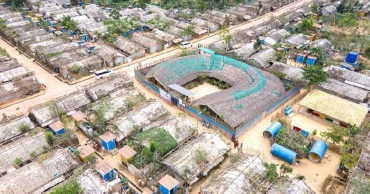Architecture
Discovering Guangzhou's Architectural Marvels
Nestled in the heart of the city, the Guangzhou Urban Planning Exhibition Center offers a glimpse into the city’s fascinating history, sustainable development, and dynamic future, while the iconic Canton Tower lights up the skyline with its breathtaking display of innovation and design. These landmarks highlight why this city is a must-visit for architecture enthusiasts and casual tourists alike.
Gateway to Yesterday and Tomorrow: Guangzhou Urban Planning Exhibition Center
The Guangzhou Urban Planning Exhibition Center isn't just another museum. Encased in a shimmering glass veneer, this center captivates from the first step inside, where a sprawling scale model of Guangzhou commands attention, portraying the intricate dance between the city’s historical layers and its leaps towards tomorrow.
Navigating through the center, each floor unfolds like chapters in a sci-fi novel, from Guangzhou’s humble beginnings to its thrust into the megacity league. Augmented reality setups bring a zest of magic, transforming static urban models into dynamic landscapes bustling with potential life. Here, technology meets urban planning, creating immersive narratives that celebrate both the city's heritage and its high-tech horizon.
Read more: Bangladesh and Qatar to sign 6 deals, 5 MoUs during Qatar Emir’s state visit, says foreign minister
One can't help but be inspired by the city's ambitious vision to blend sustainability with urban growth. The center not only educates about urban planning but also ignites imaginations about the cities of the future.
1 year ago
12 boarding bridges will be operational when Dhaka Airport’s 3rd Terminal partially opens this Oct: CAAB
The third terminal of Dhaka’s Hazrat Shahjalal International Airport will be partially opened by October this year, and it is set to be fully operational next year, Civil Aviation Authority of Bangladesh (CAAB) Chairman Air Vice Marshal Muhammad Mafidur Rahman told UNB on Sunday (August 06, 2023).
The construction of the terminal is currently in its final stage and over 85 percent work has been completed, he said.
Once fully operational, the new Dhaka airport terminal, covering an area of 5,42,000 square metres, will be capable of serving more than one crore passengers annually, the CAAB chairman added. State of the art amenities will also be offered to passengers.
Read: Groundhandling contract for Terminal 3 will go to Japan: CAAB chairman
“As construction is in its final stage, the magnificent architecture of the third terminal building is now visible. Currently, work on interior decoration and installation of various types of equipment is going on,” the CAAB chief informed UNB.
2 CRORE PASSENGERS WILL BE ABLE TO USE DHAKA AIRPORT EVERY YEAR
The CAAB chairman said that currently 120-130 planes of over 30 airlines take off from and land at Hazrat Shahjalal International Airport’s Terminal 1 and Terminal 2.
“Every day about 20,000 passengers use the two terminals of the airport. As such, Dhaka airport serves around 80 lakh (8 million) passengers annually. It will be possible to serve an additional 1.2 crore passengers when the third terminal is opened,” he said.
2 years ago
'Architecture is truly global, can also be deeply local'
Princess Zahra Aga Khan, the eldest child of the Aga Khan, has said architecture is truly global and can also be deeply local, noting that the projects and the people they honour exactly show that.
"They show us how architecture can create dialogue among people, build bridges between communities, and act as places of sanctuary for those in need," she said.
The 15th cycle of the Award was concluded with a prize giving ceremony in Muscat on Monday night.
Winners of the 2022 Aga Khan Award for Architecture shared the stage with Crown Prince of Oman Sayyid Theyazin Bin Haitam Al Said and Princess Zahra Aga Khan at Royal Opera House of Musical Arts, Muscat.
Officials of the Sultanate of Oman, architectural experts, the Award’s Steering Committee and members of its Master Jury, as well as dignitaries from around the world were present.
Economist and social thinker Hossain Zillur Rahman and Country Director, ActionAid Bangladesh Farah Kabir were present.
Of the 463 projects from 55 countries nominated for this year’s award, the Master Jury selected 20 to visit and evaluate.
The six winning projects (2 from Bangladesh) of the 2022 Aga Khan Award for Architecture embody an inclusive, pluralistic outlook which were chosen to share the $1m prize.
Other winning projects came from Indonesia, Iran, Lebanon and Senegal, and range equally widely in their execution.
“The Award has been a lighthouse to those who feel we can design and build differently; to those who believe we have a responsibility to build appropriately," said Princess Zahra Aga Khan.The Award for Architecture ceremony concluded the three-day event, which also celebrated laureates of the 2022 Aga Khan Music Awards.
These laureates were featured in two gala concerts presented in the Royal Opera House Muscat’s House of Musical Arts.
Read more: Global recognition proves Bangladeshi architecture can become an example for countries
The evening included a performance by the Aga Khan Master Musicians with special guest Yurdal Tokcan, an eminent oud player who served on the Master Jury of the 2022 Music Awards, and the screening of a film on the 2022 Award recipients.
“The Sultanate of Oman’s hosting of the ceremony of the Aga Khan Awards for Architecture and Music and its accompanying events support the objectives of Oman’s cultural strategy, which calls for an identity open to the cultures of peoples; affirms the continuous support for culture, literature and the arts; and puts the role of the Sultanate of Oman on the world map of culture as well as achieves partnership and integration with local and international institutions in the cultural fields,” said Sayyid bin Sultan Al-Busaidi, addressing the gathering.
The Aga Khan Award for Architecture, now in its 45th year, was established to encourage such architectural excellence.
The Award recognises the innovative use of local resources and appropriate technology to successfully address the physical, social and economic needs, and the cultural aspirations of communities in which Muslims have a significant presence.
Above all, the Award celebrates projects that promote a spirit of pluralism: in the words of the Aga Khan, the embrace, rather than the elimination, of difference.
Princess Zahra Aga Khan, representing the Aga Khan at the Awards, paid tribute to the host, Sultan Haitham bin Tariq, and the Sultanate of Oman, as well as Sayyid Theyazin bin Haitam Al Said, for his presence.
“Celebrating the Award here in Oman,” she said to the gathering, “reflects a deep and shared conviction that buildings can do more than simply house people and programmes, they can also reflect our deepest values.”
She said that Aga Khan believes profoundly that architecture is not just about building but is a means of improving people’s quality of life.
Read more: This architect couple chose to live in Jhenaidah, designed an award-winning river space
Princess Zahra Aga Khan’s address emphasised both the pluralistic philosophy of the Award and the need for architecture to find solutions to physical and environmental concerns.
“Over the years, the Award has been a lighthouse to those who feel we can design and build differently; to those who believe we have a responsibility to build appropriately – with thought, with consideration, and with the knowledge that architecture at its best is an inherently pluralistic enterprise.
It is our honour to recognise each of you for the spaces you designed in the service of humankind. Taken together, they help us better imagine an architecture for the future that will acknowledge the needs of diverse communities, respect the natural world, and enhance the quality of life,” she ended.
“Every project has a story - about how it has been conceived, built and lived - that cannot be explained simply through drawings and images," said Farrokh Derakhshani, Director of the Aga Khan Award for Architecture.
3 years ago
This architect couple chose to live in Jhenaidah, designed an award-winning river space
Khondaker Hasibul Kabir and Suhailey Farzana, an architect couple from Jhenaidah in Bangladesh, have shown the world how they co-designed a public space in their own town – keeping in mind the nature and people.
Their community-led initiative titled “Urban River Spaces, Jhenaidah” is one of the winners of the 2022 Aga Khan Award for Architecture.
Six award winners, who will share the $1 million award – one of the largest in architecture – show promise for communities, innovation and attention to environment.
Read: 2 Bangladesh projects win 2022 Aga Khan Award for Architecture
The award giving ceremony will be held at Royal Opera House of Musical Arts Monday night (Muscat time).
“This is not a project, I would say, rather it’s a process that has begun,” Farzana, who came to Muscat with his husband and son, told UNB hours before receiving the prestigious award.
3 years ago
Global recognition proves Bangladeshi architecture can become an example for countries
Bangladesh can be an example for other countries if people from all disciplines, not just the architects, can put in their best efforts for the country, says a young architect.
“We got the recognition relatively in a very early stage. It proves that those in the architecture discipline are demonstrating world class examples,” architect Saad Ben Mostafa told UNB.
Mostafa is one of the three young architects whose project titled “Community Spaces in Rohingya Refugee Response, Cox’s Bazar” won the prestigious 2022 Aga Khan Award for Architecture (AKAA).
Six winners, who will share the USD 1 million award, one of the biggest in architecture, show promise for communities, innovation and care for the environment.
Read more: 2 Bangladesh projects win 2022 Aga Khan Award for Architecture
Mostafa along with his two teammates — architects Khwaja Fatmi and Rizvi Hassan — will receive the award with other winners on Monday.
The graduate from the Bangladesh University of Engineering and Technology (BUET) laid emphasis on focusing on work while understanding people’s needs and roots, not just replicating foreign designs.
“I would say, we are going to receive the award on behalf of all. I see it as a big recognition for Bangladesh,” architect Fatmi told UNB.
Architect Hassan said they wanted to see whether they can work based on local elements – taking materials and creating a beautiful, sustainable and an advanced design.
Read More: Bangladesh project among Aga Khan Award for Architecture Winners
In future, he said, they want to work in rural areas. “We want to engage people from the villages in our work. We want to see them join hands with us. We will work together.”
3 years ago
2 Bangladesh projects win 2022 Aga Khan Award for Architecture
Two Bangladesh projects are amongst six winners of the 2022 Aga Khan Award for Architecture (AKAA).
A monograph that includes essays on issues raised by the Master Jury’s selections of the shortlist and the winners for the 2022 Award will be published by Architangle in October 2022, according to a message received from Geneva.
The Urban River Spaces project in Jhenaidah created by Khondakar Hasibul Kabir and Suhailey Farzana, and the community spaces of the Rohingya Refugee Response program by architects Rizvi Hassan, Khwaja Fatmi and Saad Ben Mostafa will share the US$1 million award with four other winning projects.
Read: Bangladeshi projects shortlisted for Aga Khan Award for Architecture 2022
3 years ago
USG demands to protect heritage sites
Urban Study Group (USG) formed a Human chain rally in front of the National Museum at Shahabag demanding to protect 100 years aged heritage architectures of Old Dhaka.
They demanded to stop demolishing the traditional 'Nilam Ghar' of Old Dhaka which govt. has leased to Bar Association for one year.
But Bar Association has planned to make a six storied building breaking the law and verdicts of high court as it is prohibited to destroy such heritage sites.
"Bar Association has already broke a huge portion of the traditional Nilam Ghar though we protested it and informed it to the proper authorities to take urgent initiatives but authorities didn’t take any proper action," main executive of USG, Taimur Rahman said.
3 years ago
Master Jury announced for 2022 Aga Khan Award for Architecture
The Aga Khan Award for Architecture has announced the nine-member Master Jury for the 2020-22 cycle. From Bangladesh, Prof Kazi Khaleed Ashraf, Director-General of Bengal Institute for Architecture, has been named as a juror.
The nine-member Master Jury will convene in January 2022 to select a shortlist from hundreds of nominated projects. The jurors will meet for a second time in summer 2022 to examine the on-site reviews and select the final recipients of the prestigious US$ 1 million Award that's given every three years.
Read: Aga Khan Academy set to develop future leaders for Bangladesh
In fact, once the Master Jury selects a shortlist, the shortlisted projects are then subjected to rigorous on-site reviews by independent experts, most of them architects, conservation specialists, planners or structural engineers.
The selection process emphasises architecture that not only provides for people’s physical, social and economic needs, but that also stimulates and responds to their cultural aspirations.
Particular attention is given to building schemes that use local resources and appropriate technology in innovative ways and to projects likely to inspire similar efforts elsewhere.
The Aga Khan Award for Architecture is governed by a Steering Committee chaired by the Aga Khan Foundation.
The other members of the Steering Committee are Sheikha Mai Bint Mohammed Al Khalifa, President of Bahrain Authority for Culture and Antiquities, Manama; Emre Arolat, Founder, EAA-Emre Arolat Architecture, Istanbul; Meisa Batayneh, Principal Architect, Founder, Maisam Architects and Engineers, Amman; and Sir David Chipperfield, Principal, David Chipperfield Architects, London.
Read: Bangladeshi Marina Tabassum in Aga Khan Award for Architecture’s Steering Committee
The other members are Souleymane Bachir Diagne, Director, Institute of African Studies, Columbia University, New York; Nasser Rabbat, Aga Khan Professor, Massachusetts Institute of Technology, Cambridge; Marina Tabassum, Principal, Marina Tabassum Architects, Dhaka; and Sarah M Whiting, Dean, Graduate School of Design, Harvard University, Cambridge.
Farrokh Derakhshani is the Director of the Award.
4 years ago
TSC Renovation: How will the new look be?
The Teacher-Student Centre, popularly known as TSC on the Dhaka University (DU) campus, was established in 1961. It is set to be renovated keeping its old structure as part of the university’s birth centenary celebrations in 2021.
The University authority primarily approved the new design provided by The Public Works Department (PWD) of the government but the construction work will start after Prime Minister’s approval. Before that, PWD proposed to rebuild TSC entirely, which sparked debate and anger among students, teachers and alumni.
Later, the authorities instructed PWD to form a new design keeping its old structure. After several meetings, both stakeholders signed off on the new design.
Also read: TSC reconstruction: DU authorities seek opinion from teachers, students
Prime Minister Sheikh Hasina on September 2 last year said a plan to modernize Dhaka Medical College Hospital (DMCH), TSC and Shahbagh’s Public Library. "Dhaka University is our university and we want to build TSC in a modern way," said the PM on that day.
She also said that she had already directed the authorities concerned to prepare its design in a proper manner.
What will the new TSC complex look like?
According to the new draft design, TSC’s present structure will not be demolished. A 10-storied new building will be constructed where the swimming pool is now located.
“The new facility will be built and incorporated with the existing structure. It will include rehearsal rooms for cultural activities, rooms with modern facilities for TSC-based socio-cultural groups, indoor games room, separate cafeteria, two auditorium, gymnasium, teachers’ lounge, two basements for vehicle parking, and more,” said Acting Director Syed Ali Akbar.
Read 5-storey building tilts in Chattogram: Residents evacuated
He said the entrance of the new building would be from the west of TSC. The construction work will be started from the back where now the swimming pool is situated.
“Our engineering section is not involved with the designing or construction work, moreover the PWD will do as per the prime minister’s instruction,” he continued.
Mir Manzurur Rahman, Chief Architect, Department of Architecture, Ministry of Housing and Public Works, said, “We did a draft design following DU’s requisition. We cover almost all of the requisition including two auditoriums, a lecture theater, a gymnasium and some office space and others. We insert these requisitions into 10 storied building and Dhaka University is happy with our design.”
“Old existing structures will not be rebuilt. We will just renovate existing structures as per necessity,” he added.
The TSC director provided a requisition list to the university's engineering department, which was subsequently submitted to PWD on October 18 last year by the DU authorities.
The acting chief engineer of DU Abul Kalam Sikder said, “PWD will provide the new design to the prime minister and if she approves the design, they will start construction work."
DU pro vice-chancellor (administration) Prof Muhammad Samad said, “This design is acceptable. It will be handed over to prime minister though PWD and final work will start if the PM approves the design.”
Prof Samad hoped that construction work would begin soon under the direct concern of the prime minister.
Also read: Bangabandhu’s historic photo kept at TSC
Mohiuddin Mahi, a third-year student of Mass Communication and Journalism said, TSC is the social and cultural hub of our campus which was built when the varsity had a small number of students.
“However, it has never been reconstructed again although the number of students and teachers has been increasing every year. So, this is a great initiative indeed but the authorities have to be sincere enough so that none of its tradition or aesthetic beauties get destroyed,” he added.
Echoing Mahi, Salman Siddique, president of Socialist students’ front said, "Yes, there is a need to improve some aspects of TSC. We do not oppose modernization of TSC either. But authority have to be more sincere so that none of tradition and beauties get destroyed.”
But there are lots of problems including accommodation crisis authority should pay heed first, he said.
Read Construction work on Dhaka airport’s new terminal likely to begin in Dec
TSC at a glimpse
The TSC is an invaluable part of Bangladesh’s cultural heritage and among the modern architectural landmarks of the country.
The Greek legendary architect, planner and theoretician Constantinos Apostolos Doxiadis (1913-1975) designed TSC during the early 1960s and later the TSC building was built as part of the so-called Decade of Development (between 1958 and 1968) of the then Pakistani regime.
The structure exemplifies a modernist architectural sensitivity toward spatial needs for tropical climatic conditions. It blends local parameters of space-making -- particularly the indoor-outdoor continuum and generation of space around courtyards -- with international-style visual expression of building forms.
TSC's dome-shaped structure is considered an iconic landmark in Dhaka city. It has been home to countless students who show up between or after classes for a cup of tea with friends, and holds immense nostalgic value for them on top of being a historically significant site.
There were several attempts to renovate the structure earlier, but they were stopped subsequently. One of them was to demolish the swimming pool next to the TSC and build a nine-storey building. The initiative of renovation by keeping the original structure intact, however, did not see the light of day.
Read PM orders proper renovation of shabby rail bridges
4 years ago
Bangladeshi Marina Tabassum in Aga Khan Award for Architecture’s Steering Committee
Renowned Bangladeshi architect Marina Tabassum has been included in the Steering Committee of Aga Khan Award for Architecture for the 2020-2022 cycle.
4 years ago








.jpg)
.jpg)






